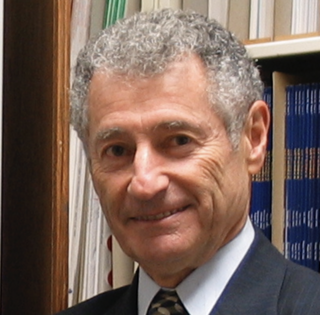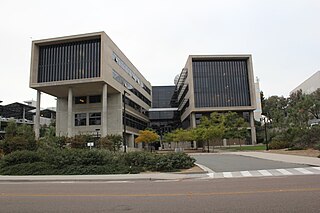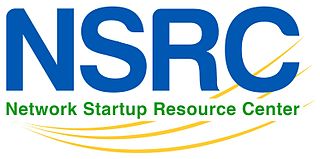Related Research Articles

The history of the Internet has its origin in the efforts of scientists and engineers to build and interconnect computer networks. The Internet Protocol Suite, the set of rules used to communicate between networks and devices on the Internet, arose from research and development in the United States and involved international collaboration, particularly with researchers in the United Kingdom and France.

In telecommunications, packet switching is a method of grouping data into packets that are transmitted over a digital network. Packets are made of a header and a payload. Data in the header is used by networking hardware to direct the packet to its destination, where the payload is extracted and used by an operating system, application software, or higher layer protocols. Packet switching is the primary basis for data communications in computer networks worldwide.
The National Science Foundation Network (NSFNET) was a program of coordinated, evolving projects sponsored by the National Science Foundation (NSF) from 1985 to 1995 to promote advanced research and education networking in the United States. The program created several nationwide backbone computer networks in support of these initiatives. Initially created to link researchers to the NSF-funded supercomputing centers, through further public funding and private industry partnerships it developed into a major part of the Internet backbone.
InterNIC, known as the Network Information Center (NIC) until 1993, was the organization primarily responsible for Domain Name System (DNS) domain name allocations and X.500 directory services. From its inception in 1972 until October 1, 1991, it was run by the Stanford Research Institute, now known as SRI International, and led by Jake Feinler. From October 1991 until September 18, 1998, it was run by Network Solutions. Thereafter, the responsibility was assumed by the Internet Corporation for Assigned Names and Numbers (ICANN).

The Advanced Research Projects Agency Network (ARPANET) was the first wide-area packet-switched network with distributed control and one of the first computer networks to implement the TCP/IP protocol suite. Both technologies became the technical foundation of the Internet. The ARPANET was established by the Advanced Research Projects Agency (ARPA) of the United States Department of Defense.

Leonard Kleinrock is an American computer scientist and Internet pioneer. He is a long-tenured professor at UCLA's Henry Samueli School of Engineering and Applied Science.

SRI International (SRI) is an American nonprofit scientific research institute and organization headquartered in Menlo Park, California. The trustees of Stanford University established SRI in 1946 as a center of innovation to support economic development in the region.

The San Diego Supercomputer Center (SDSC) is an organized research unit of the University of California, San Diego (UCSD). SDSC is located at the UCSD campus' Eleanor Roosevelt College east end, immediately north the Hopkins Parking Structure.
Scott J. Shenker is an American computer scientist, and professor of computer science at the University of California, Berkeley. He is also the leader of the Extensible Internet Group at the International Computer Science Institute in Berkeley, California.

The AMPRNet or Network 44 is used in amateur radio for packet radio and digital communications between computer networks managed by amateur radio operators. Like other amateur radio frequency allocations, an IP range of 44.0.0.0/8 was provided in 1981 for Amateur Radio Digital Communications and self-administered by radio amateurs. In 2001, undocumented and dual-use of 44.0.0.0/8 as a network telescope began, recording the spread of the Code Red II worm in July 2001. In mid-2019, part of IPv4 range was sold off for conventional use, due to IPv4 address exhaustion.
A network telescope is an Internet system that allows one to observe different large-scale events taking place on the Internet. The basic idea is to observe traffic targeting the dark (unused) address-space of the network. Since all traffic to these addresses is suspicious, one can gain information about possible network attacks as well as other misconfigurations by observing it.
The Commercial Internet eXchange (CIX) was an early interexchange point that allowed the free exchange of TCP/IP traffic, including commercial traffic, between ISPs. It was an important initial effort toward creating the commercial Internet that we know today

Philip Eric Bourne is an Australian bioinformatician, non-fiction writer, and businessman. He is currently Stephenson Chair of Data Science and Director of the School of Data Science and Professor of Biomedical Engineering and was the first associate director for Data Science at the National Institutes of Health, where his projects include managing the Big Data to Knowledge initiative, and formerly Associate Vice Chancellor at UCSD. He has contributed to textbooks and is a strong supporter of open-access literature and software. His diverse interests have spanned structural biology, medical informatics, information technology, structural bioinformatics, scholarly communication and pharmaceutical sciences. His papers are highly cited, and he has an h-index above 50.

Francine Berman is an American computer scientist, and a leader in digital data preservation and cyber-infrastructure. In 2009, she was the inaugural recipient of the IEEE/ACM-CS Ken Kennedy Award "for her influential leadership in the design, development and deployment of national-scale cyberinfrastructure, her inspiring work as a teacher and mentor, and her exemplary service to the high performance community". In 2004, Business Week called her the "reigning teraflop queen".

The Network Startup Resource Center (NSRC) is a nonprofit organization, formed in 1992 and based at the University of Oregon. The organization supports deployment of Internet research and education networks in academic institutions and non-governmental organizations throughout the Asia Pacific region, Africa, Latin America and the Caribbean, and the Middle East. NSRC receives major funding and in-kind donations from the National Science Foundation (NSF), Google and Google.org, Cisco, O'Reilly Media, Vint Cerf, the Richard M. Karp Foundation, IDRC, Internet Society (ISOC), and many other institutional and private donors.

Susan Estrada is in the Internet Hall of Fame for founding CERFnet, one of the original regional IP networks, in 1988. Through her leadership and collaboration with PSINet and UUnet, Estrada helped form the interconnection enabling the first commercial Internet traffic via the Commercial Internet Exchange.

Kimberly C. "KC" Claffy is director of the Center for Applied Internet Data Analysis at the University of California, San Diego. In 2017 she was awarded the Jonathan B. Postel Service Award and inducted into the Internet Hall of Fame in 2019.

Ilkay Altintas is a Turkish-American data and computer scientist, and researcher in the domain of supercomputing and high-performance computing applications. Since 2015, Altintas has served as chief data science officer of the San Diego Supercomputer Center (SDSC), at the University of California, San Diego (UCSD), where she has also served as founder and director of the Workflows for Data Science Center of Excellence (WorDS) since 2014, as well as founder and director of the WIFIRE lab. Altintas is also the co-initiator of the Kepler scientific workflow system, an open-source platform that endows research scientists with the ability to readily collaborate, share, and design scientific workflows.
Athina Markopoulou is a Greek-American engineer who is Professor, Chancellor's Fellow, and chair at the University of California, Irvine. Her research considers internet privacy, data transparency and mobile data analytics. She was elected Fellow of the Institute of Electrical and Electronics Engineers in 2020.
References
- ↑ CERFnet Network Information Center (nic.cerf.net) (June 29, 1992), CERFnet History, archived from the original on 2004-08-20, retrieved 2021-08-12
- ↑ Malamud, Carl (1992), Exploring the Internet: A Technical Travelogue, p. 312, ISBN 978-0132968980
- ↑ Laquey, Tracy, ed. (2014), The User's Directory of Computer Networks, Elsevier, p. 263, ISBN 978-1483296418